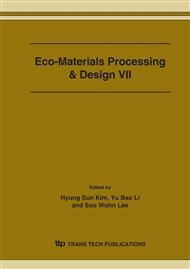p.630
p.634
p.638
p.642
p.646
p.650
p.654
p.658
p.662
Formation Characterization of Ultra-Fine Cu Powder from Cu(OH)2 Slurry by Wet Reduction Method
Abstract:
Ultra-fine copper powders with an average size of 150 nm were synthesized from Cu(OH)2 .H2O slurry with hydrazine monohydrate as a reduction agent by using the wet reduction method. Parameters such as temperature, reduction agent feeding rate, stirring rate, stirring speed, Cu(OH)2 concentration, and surfactants were investigated. It was found that the feeding rate of hydrazine monohydrate and the use of surfactants mainly affect the morphology and size of the copper powders along with their dispersion. XRD, PSA, and SEM were used to characterize the prepared particles.
Info:
Periodical:
Pages:
646-649
Citation:
Online since:
March 2006
Authors:
Price:
Сopyright:
© 2006 Trans Tech Publications Ltd. All Rights Reserved
Share:
Citation:


